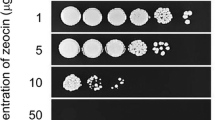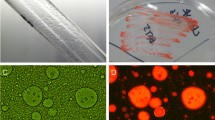Abstract
Oleaginous yeast Rhodosporidium toruloides is an excellent microbial lipid producer. Therefore, it is important to develop molecular biology tools to understand the basic mechanism for lipid accumulation and further manipulate the microorganism. High-quality RNA extraction from R. toruloides is particularly challenging due to high level of polysaccharides, lipids, and other secondary metabolites. To obtain an optimal protocol for RNA extraction from R. toruloides, four methods were evaluated. Large difference in RNA yield and quality among these protocols was found. The optimum method was modified RNAiso procedure, where RNA was isolated using liquid nitrogen-RNAiso method with salt precipitation and the addition of β-mercaptoethanol. This method consistently recovered RNA in good quality with high yield. Around 297 μg total RNA per gram of cells was obtained with an average purity measured as A260/A280 of 2.09. A titer of 105 cfu/ml could be harvested to construct a full-length cDNA library with the RNA sample in this quality. Electrophoresis gel analysis indicated the fragments ranged from 200 bp to 4.0 kb, with the average size of 1000 bp. Randomly picked clones showed the recombination efficiency at 80%. These results showed that RNA of R. toruloides was successfully extracted for the first time using the modified RNAiso method, and the cDNA library was appropriate for screening the genes related to lipid accumulation.



Similar content being viewed by others
References
Gill, C. O., Hall, M. J., & Ratledge, C. (1977). Lipid accumulation in an oleaginous yeast (Candida 107) growing on glucose in single-stage continuous culture. Applied and Environmental Microbiology, 33, 231–239.
Meng, X., Yang, J. M., Xu, X., Zhang, L., Nie, Q. J., & Xian, M. (2009). Biodiesel production from oleaginous microorganisms. Renewable Energy, 34, 1–5.
Vicente, G., Bautista, L. F., Rodriguez, R., Gutierrez, F. J., Sadaba, I., Ruiz-Vazquez, R. M., et al. (2009). Biodiesel production from biomass of an oleaginous fungus. Biochemical Engineering Journal, 48, 22–27.
Ratledge, C. (2002). Regulation of lipid accumulation in oleaginous micro-organisms. Biochemical Society Transactions, 30, 1047–1050.
Ratledge, C., & Wynn, J. P. (2002). The biochemistry and molecular biology of lipid accumulation in oleaginous microorganisms. Advances in Applied Microbiology, 51, 1–51.
Liu, B., Sun, Y., Li, Y. H., & Zhao, Z. B. (2005). Progress on microbial glyceride biosynthesis and metabolic regulation in oleaginous microorganisms. Acta Microbiologica Sinica, 45, 153–156.
Tang, W., Zhang, S. F., Wang, Q., Tan, H. D., & Zhao, Z. K. (2009). The isocitrate dehydrogenase gene of oleaginous yeast Lipomyces starkeyi is linked to lipid accumulation. Canadian Journal of Microbiology, 55, 1062–1069.
Turcotte, G., & Kosaric, N. (1988). Biosynthesis of lipids by Rhodosporidium toruloides ATCC 10788. Journal of Biotechnology, 8, 211–237.
Li, Y. H., Zhao, Z. B., & Bai, F. W. (2007). High-density cultivation of oleaginous yeast Rhodosporidium toruloides Y4 in fed-batch culture. Enzyme and Microbial Technology, 41, 312–317.
Liu, H. W., Zhao, X., Wang, F. J., Li, Y. H., Jiang, X. N., Ye, M. L., et al. (2009). Comparative proteomic analysis of Rhodosporidium toruloides during lipid accumulation. Yeast, 26, 553–566.
Wang, X. X., Wang, B., Liu, L. J., Cui, X. P., Yang, J. Y., Wang, H., et al. (2010). Isolation of high quality RNA and construction of a suppression subtractive hybridization library from ramie (Boehmeria nivea L. Gaud.). Molecular Biology Reports, 37, 2099–2103.
Marguerat, S., & Bahler, J. (2010). RNA-seq: From technology to biology. Cellular and Molecular Life Sciences, 67, 569–579.
Baker, S. S., Rugh, C. L., & Kamalay, J. C. (1990). RNA and DNA isolation from recalcitrant plant tissues. Biotechniques, 9, 268–272.
Birtic, S., & Kranner, I. (2006). Isolation of high-quality RNA from polyphenol-, polysaccharide- and lipid-rich seeds. Phytochemical Analysis, 17, 144–148.
Sambrook, J., & Russell, D. W. (2001). Molecular cloning: A laboratory manual. New York: Cold Spring Harbor Laboratory Press.
Portillo, M., Fenoll, C., & Escobar, C. (2006). Evaluation of different RNA extraction methods for small quantities of plant tissue: Combined effects of reagent type and homogenization procedure on RNA quality-integrity and yield. Physiologia Plantarum, 128, 1–7.
Wang, X. C., Tian, W. M., & Li, Y. X. (2008). Development of an efficient protocol of RNA isolation from recalcitrant tree tissues. Molecular Biotechnology, 38, 57–64.
Zhong, Z. P., & Wu, N. H. (1997). Stability of mRNA in eukaryote. Progress in Biotechnology, 17, 34–38.
Murao, S., Yamamoto, R., & Arai, M. (1976). Isolation and identification of red yeast cell wall lytic enzyme producing microorganism. Agricultural and Biological Chemistry, 40, 23–26.
de Coana, Y. P., Parody, N., Fernandez-Caldas, E., & Alonso, C. A. (2010). Modified protocol for RNA isolation from high polysaccharide containing Cupressus arizonica Pollen. Applications for RT-PCR and phage display library construction. Molecular Biotechnology, 44, 127–132.
Ghangal, R., Raghuvanshi, S., & Sharma, P. C. (2009). Isolation of good quality RNA from a medicinal plant seabuckthorn, rich in secondary metabolites. Plant Physiology and Biochemistry, 47, 1113–1115.
Chomczynski, P., & Sacchi, N. (1987). Single-step method of RNA isolation by acid guanidinium thiocyanate-phenol-chloroform extraction. Analytical Biochemistry, 162, 156–159.
Schmitt, M. E., Brown, T. A., & Trumpower, B. L. (1990). A rapid and simple method for preparation of RNA from Saccharomyces cerevisiae. Nucleic Acids Research, 18, 3091–3092.
Li, Y., Wang, W. Y., Du, X. L., & Yuan, Q. P. (2010). An improved RNA isolation method for filamentous fungus Blakeslea trispora rich in polysaccharides. Applied Biochemistry and Biotechnology, 160, 322–327.
Mannan, M. A. U., Sharma, S., & Ganesan, K. (2009). Total RNA isolation from recalcitrant yeast cells. Analytical Biochemistry, 389, 77–79.
Wang, K., Wang, Y., Bao, Y. L., Meng, X. Y., Wu, Y., & Li, Y. X. (2006). A method for high-quality RNA extraction from Panax ginseng plant tissues. Progress in Biochemistry and Biophysics, 33, 95–99.
Hilz, H., Wiegers, U., & Adamietz, P. (1975). Stimulation of proteinase K action by denaturing agents: Application to the isolation of nucleic acids and the degradation of ‘masked’ proteins. European Journal of Biochemistry, 56, 103–108.
Chan, C. X., Teo, S. S., Ho, C. L., Othman, R. Y., & Phang, S. M. (2004). Optimisation of RNA extraction from Gracilaria changii (Gracilariales, Rhodophyta). Journal of Applied Phycology, 16, 297–301.
Shi, H. Z., & Bressan, R. (2006). RNA extraction. Methods in Molecular Biology, 323, 345–348.
Thanh, T., Omar, H., Abdullah, M. P., Chi, V. T. Q., Noroozi, M., Ky, H., et al. (2009). Rapid and effective method of RNA isolation from green microalga Ankistrodesmus convolutus. Molecular Biotechnology, 43, 148–153.
Wang, X. W., Xiong, A. S., Yao, Q. H., Zhang, Z., & Qiao, Y. S. (2010). Direct isolation of high-quality low molecular weight RNA of pear peel from the extraction mixture containing nucleic acid. Molecular Biotechnology, 44, 61–65.
Azevedo, H., Lino-Neto, T., & Tavares, R. M. (2003). An improved method for high-quality RNA isolation from needles of adult maritime pine trees. Plant Molecular Biology Reporter, 21, 333–338.
Sharma, A. D., Gill, P. K., & Singh, P. (2003). RNA isolation from plant tissues rich in polysaccharides. Analytical Biochemistry, 314, 319–321.
Singh, G., Kumar, S., & Singh, P. (2003). A quick method to isolate RNA from wheat and other carbohydrate-rich seeds. Plant Molecular Biology Reporter, 21, 93a–93f.
Yao, J. T., Fu, W. D., Wang, X. L., & Duan, D. L. (2009). Improved RNA isolation from Laminaria japonica Aresch (Laminariaceae, Phaeophyta). Journal of Applied Phycology, 21, 233–238.
de Jong, M., Rauwerda, H., Bruning, O., Verkooijen, J., Spaink, H. P., & Breit, T. M. (2010). RNA isolation method for single embryo transcriptome analysis in zebrafish. BMC Research Notes, 3, 73–78.
Kocabiyik, S. (1996). Modified method for RNA isolation from bacteria by guanidinium thiocyanate-cesium chloride centrifugation. Biotechniques, 18, 570–572.
Wu, Y., Llewellyn, D. J., & Dennis, E. S. (2002). A quick and easy method for isolating good-quality RNA from cotton (Gossypium hirsutum L.) tissues. Plant Molecular Biology Reporter, 20, 213–218.
Wang, D. H., Wang, B. C., Li, B., Duan, C. R., & Zhang, J. (2004). Extraction of total RNA from Chrysanthemum containing high levels of phenolic and carbohydrates. Colloids and Surfaces B-Biointerfaces, 36, 111–114.
Pearson, G., Lago-Leston, A., Valente, M., & Serrao, E. (2006). Simple and rapid RNA extraction from freeze-dried tissue of brown algae and seagrasses. European Journal of Phycology, 41, 97–104.
Su, X., & Gibor, A. (1988). A method for RNA isolation from marine macro-algae. Analytical Biochemistry, 174, 650–657.
Acknowledgments
This work was supported by the Knowledge Innovation Program of the Chinese Academy of Sciences (No. K2006A22).
Author information
Authors and Affiliations
Corresponding author
Electronic supplementary material
Below is the link to the electronic supplementary material.
Rights and permissions
About this article
Cite this article
Yang, F., Tan, H., Zhou, Y. et al. High-Quality RNA Preparation from Rhodosporidium toruloides and cDNA Library Construction Therewith. Mol Biotechnol 47, 144–151 (2011). https://doi.org/10.1007/s12033-010-9322-1
Published:
Issue Date:
DOI: https://doi.org/10.1007/s12033-010-9322-1




